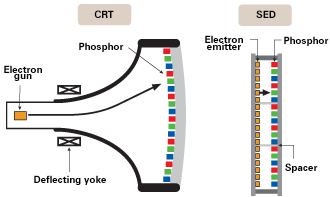
Posted on Saturday, February 24 2007 @ 3:11 CET by Thomas De Maesschalck
Another roadblock for SED displays pops up
as Canon lost a lawsuit this week:
Judge Samuel Sparks, with the U.S. District Court for the Western District of Texas, ruled in a summary judgment Thursday that Canon violated its agreement with Texas-based Nano-Proprietary by forming a joint television venture with Toshiba.
Nano-Proprietary licensed its technology for making screens and displays out of carbon nanotubes to Canon in 1999. By bringing in Toshiba as a partner, Nano-Proprietary argued that Canon breached the agreement.
Canon, and until recently Toshiba, has been trying to bring to market a TV based around surface-conduction electron-emitter displays. In these displays, which are similar to Nano-Proprietary's, tiny particles blast electrons onto a screen and create images. The screens--in the lab at least--have a sharper resolution than LCD or plasma TVs but are far thinner than traditional cathode ray tube TVs. The project, however, has been subject to several delays.
Damages still need to be determined, a source close to the case said. Canon would also have to negotiate a new agreement if it wants to continue producing these kinds of TVs, assuming the summary judgment ruling stands after any appeals. The case was filed by Nano-Proprietary in 2005.
